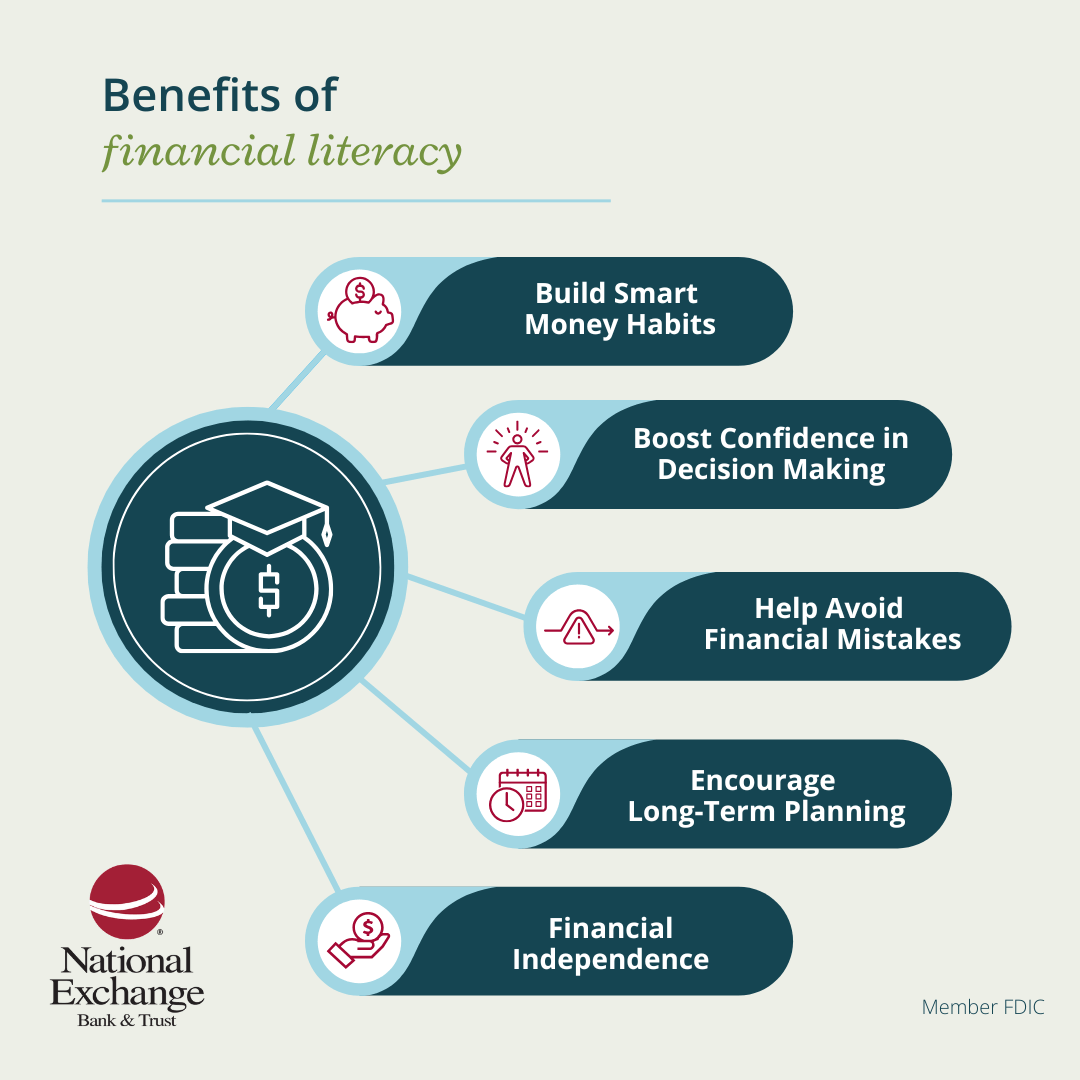April is Financial Literacy Month, a time to highlight the importance of financial education. It’s a great time to reflect on how you have been helping the kids in your life develop money management skills or create a plan to help start their financial education journey. Imagine a world where every child grows up with the skills to manage their finances responsibly, making informed financial choices as they navigate life’s challenges. This month offers a special opportunity to reflect on how we can make that vision a reality!
Explore the benefits of financial literacy, get helpful tips for introducing money concepts to your kids, and find out how National Exchange Bank & Trust can be a partner in setting them on the path to financial success through our Youth Financial Programs. Let’s help them build a strong foundation for their future!
Benefits of Financial Literacy for Kids
Teaching kids how to manage money isn’t just about handing them cash or setting up a savings account—it’s about giving them the tools they’ll carry with them for the rest of their lives. Imagine a child deciding how to spend their allowance, carefully planning for a big purchase, or even managing debt when they’re older.
Take, for example, the moment when a child learns the difference between needs and wants. Suddenly, they’re not rushing to buy every toy or gadget they see. Instead, they begin to make thoughtful choices and avoid impulsive ones. When they grasp the importance of budgeting and saving, they start to see the bigger picture—learning how to plan ahead, make responsible decisions, and take control of their financial future.
The advantages of financial literacy for kids are far-reaching. The earlier kids are exposed to financial education, the more likely they are to manage their finances responsibly in adulthood. Learn how to help them build a bright financial future with National Exchange Bank & Trusts’ Steps Youth Financial Programs.
Steps Youth Financial Programs
Why Financial Literacy is Important
Financial literacy for kids is important as it helps build the tools and resources one needs to understand the concepts of money management. At a basic level for kids this can include how to earn, save and spend, wisely. Advantages of teaching financial literacy to kids starting from a young age include:
- Developing Smart Money Habits Early. When kids learn how to manage money from a young age, they are more likely to adopt responsible financial habits. This early knowledge leads to better decision-making in adulthood, such as avoiding debt, saving for retirement, and investing wisely.
- Building Confidence in Financial Decision-Making. Financial literacy boosts confidence. When kids understand how money works, they feel more empowered to make smart decisions—whether it’s budgeting their allowance or making bigger purchases as they get older.
- Helping Avoid Financial Pitfalls. One of the major benefits of financial literacy is helping kids avoid common financial pitfalls as they get older. Without this education, many young adults make mistakes that can haunt them for years—such as overspending, accruing debt, or failing to save. Teaching kids about managing money helps prevent these mistakes.
- Encouraging Long-Term Financial Planning. Financial literacy isn’t just about managing immediate needs—it’s about understanding the importance of long-term financial goals. Kids who are taught about the benefits of saving for college, buying a home, or even starting a retirement fund are more likely to plan ahead and make choices that support their future financial security.
- Promoting Financial Independence. Financially literate kids grow into independent adults who can manage their finances on their own and understand when and where to seek advice. This independence is vital for their self-esteem and overall well-being, as they can support themselves, set financial goals, and achieve them on their own.

Tips for Teaching Kids Financial Literacy
There are many ways to introduce kids to the concept of financial literacy. Start small by teaching them how to save in a savings account, and gradually increase the complexity of their financial education. Here are some strategies to get started:
- Use Allowances. Giving kids an allowance is a great way to help them understand budgeting. Encourage them to set aside a portion for saving, spending, and even donating to charity.
- Engage in Money Conversations. Have open discussions about money. Talk about how money is earned, why it’s important to save, and how it can be used wisely.
- Use Games and Apps. There are many fun tools and games that teach kids about money management, like board games or digital apps that simulate saving, spending, and investing.
Find Financial Education Resources – You Don’t Have to Do It Alone!
There are plenty of age-appropriate lessons and activities out there to help you get started without having to recreate the wheel. A great example is our financial education resource pages, including our pages for children, teens and young adults.
Financial Education Resources




